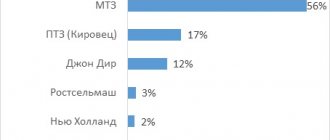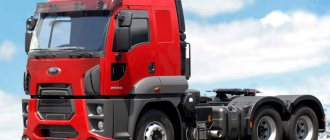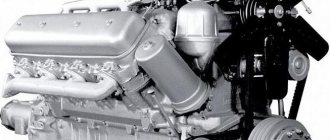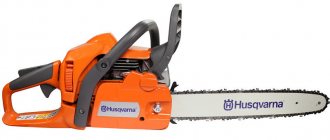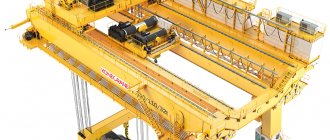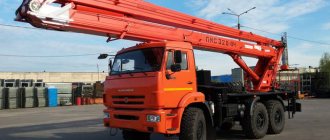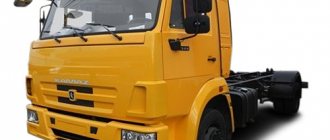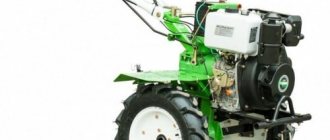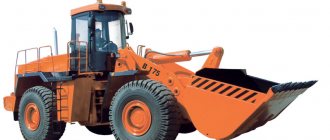Forwarders are multifunctional self-propelled equipment used in the logging industry to transport timber to places for its subsequent processing. They are a two-module machine, which is equipped with a cabin with a control system and a cargo trolley with a crane. This technique is characterized by powerful traction force, impressive cross-country ability and large load capacity. Forwarders are capable of performing several important tasks at once, allowing you to save time and effort on material procurement. At the same time, they easily overcome difficult terrain, allowing you to carry out work in hard-to-reach parts of the forest.
Principle of operation
A modern forwarder is capable of collecting, sorting, loading, transporting and unloading timber. The workpieces are moved using a hydraulic manipulator, which can rotate around its axis and perform work along the entire perimeter of the machine. The operation is carried out as follows: the crane grabs a log, lifts it and moves it to the desired location, and then releases it. Most forwarders are equipped with an eight- or six-wheel chassis with a powerful hydrostatic-mechanical transmission. Thanks to this, the equipment moves easily even on uneven terrain.
The crane is controlled from the cab, where there is a swivel driver-operator seat with levers and buttons mounted on the armrest. Modern forwarders are equipped with powerful halogen headlights that provide effective illumination of the work area. This allows loading at any time of the day. In combination with a special combine, the forwarder can be used for logging using Scandinavian technology, when wood that has already been processed and ready for further use is moved into the cargo compartment.
Average load capacity
Self-propelled mechanisms of the “1110E” and “1210E” models are designed for clear-cutting and restoration work, as well as thinning of young and old forests.
At the same time, they are able to move along steep slopes and rough terrain with difficult ground. Having an eight-wheel chassis with all-wheel drive, these units move along difficult roads at a fairly high speed.
Load capacity of “1110E” is 12 tons. It has a 183 hp engine. s., which provides a traction force of 160 kN. Loading is carried out by the CF5 manipulator.
The 1210E model can transport material weighing up to 13 tons. This forwarder has an internal combustion engine with a capacity of 188 hp. With. Traction force 175 kN. The machine is equipped with a more powerful CF7 manipulator.
Model 1210E
The cabin on these models is highly ergonomic.
All controls are located on the armrests of the operator's seat, which has air suspension.
The machine has two rear view cameras that provide full control over loading and reversing.
Full rotation of the cabin in conjunction with the manipulator ensures quick loading of bundles of timber. This significantly increases productivity when performing work.
Load sensors are installed on the boom, which provides full control over the progress of work and guarantees safety during loading.
Let's compare models: 1110E and 1210E:
| Specifications | 1110E | 1210E |
| Length (standard) | 9,570 mm | 9,570 mm |
| Width (with 600 series tires) | 2,000 mm | 2,746 mm |
| Transport height | 3 800 mm | 3 800 mm |
| Clearance | 660 mm | 660 mm |
| Machine weight | 17,300 mm | 18 100 mm |
| Turning radius on external tires | 8 243 mm | 8 243 mm |
| Load area | 4.5 sq. m | 4.8 sq. m |
The new John Deere 1110E forwarder without any mileage can be purchased on the Russian market at a price starting from 13.6 million rubles. At the same time, the used model “1210E” is offered at a price of 13 million rubles, and a new one – 17 million rubles.
On the special equipment market today there are many offers for the sale of the “1110D” model produced in 2005-2008. This model is no longer in serial production; it is considered obsolete. The price for such a car is from 3.5 to 8.0 million rubles.
Features of the forwarder
To carry out skidding, tractors are often used (specialized skidders or agricultural ones with an installed winch). However, they are significantly inferior to the forwarder in power. Skidding using a forwarder consists of the following main steps:
- empty run;
- timber loading;
- moving around loading points;
- transportation;
- unloading at the destination.
When using a forwarder, 40% of the total time required for skidding is spent on loading wood. Unloading takes about 20%. Due to the increased power compared to tractors, increased productivity is achieved. This helps to optimize the cost of the logging process. Maximum productivity of the forwarder is achieved when it is used simultaneously with the harvester at the entrance of the workpiece. This allows you to immediately remove the cut materials. In the summer, wood should be stored on the site for no more than two days, otherwise the risk of infection by various insect pests increases. And in winter, the prompt removal of felled trees is determined by weather conditions: the materials may be covered with snow.
Fuel wood skidding
Fuelwood includes trees or small-diameter logs, logging residues (boughs, tops) and stumps. Fuelwood at the loading point or in the upper warehouse should be stacked in piles that facilitate its intensive drying. Depending on the type of wood being skidded (stem, branches, stumps), the forwarder can be equipped with various grippers (grabs) and devices for laying fuel wood for skidding (bodies).
When forming fuelwood stacks, the following recommendations should be followed:
- When unloading fuel wood, the forwarder is most often installed perpendicular to the stack (Fig. 32). At the same time, the forwarder’s operation with all types of fuel wood is simplified. Unloading trees or logs due to their large length is only possible with a perpendicular position of the forwarder. When unloading, stumps or branches sometimes fall in the stack area and do not need to be further shifted. The process of stacking stumps and branches is simplified when the forwarder is perpendicular to the stack.
- It is necessary to lay logs under the stack, which prevent contact of fuel wood with the ground, improve its ventilation and drying.
- Trees and canes should be laid with their butts to the logging pole. This simplifies the operation of the chipping machine. stacks should be located in a ventilated area.
- The height of the stack should be 4–5 m. To prevent the fuel wood from getting wet, a “canopy” should be formed at the top of the stack.
- It is advisable to cover the stacks and secure the covering material, as shown in Fig. 33.
Rice. 32. Forwarder position when unloading fuel wood
Rice. 33. Stack of fuel wood
244
Types of forwarders
By type of chassis. Most of this equipment has a wheelbase with the formula 8 x 8, 6 x 6 or 4 x 4. Forwarder wheels can be supplemented with snow chains or track pads. There are also separate models with rubber-metal tracked chassis.
According to lightness class. This criterion is determined by the weight of the machine. Light forwarders typically weigh between 5 and 10 tons. The middle class is represented by equipment weighing 10–15 tons. The weight of heavy and super-heavy vehicles is 15–20 tons.
According to the parameters of the cargo compartment. The forwarder trolley consists of a front lattice wall and side bunks. The capacity of the compartment can be 5–25 cubic meters. In this case, the design of the trolley can be either fixed or transformable (change in geometry, volume).
Occupational safety requirements in emergency situations
4.1. In case of fire, take measures to extinguish it using available means.
If fuel or lubricant ignites, cover the flames with sand, earth or cover with a tarpaulin. Never pour water into burning grease or fuel.
If you notice smoke, excessive heat, smell of burnt rubber or hot brakes, or any other sign that a tire bead is on fire, you should immediately move the vehicle away. Immediately park the car, get down and move at least 150 m away from it.
Do not allow anyone near the car until the tire has cooled down. This may take from 4 to 8 hours.
If it is impossible to extinguish the fire on your own, you must call the nearest fire brigade using frequent sound signals, by telephone, radio or other means, and inform your immediate supervisor.
4.2. In the event of an accident, provide first aid to the victim, inform the foreman or other official about the incident, if necessary, call an ambulance or take measures to deliver the victim to a medical facility, and, if possible, preserve the situation of the incident.
4.3. It is prohibited to carry out work when the wind speed is more than 11 m/s, during a thunderstorm, during heavy rains and in thick fog (visibility less than 50 m).
Main technical characteristics
Today, forwarders are available for sale in dozens of models. To choose a car, you must take into account the following technical characteristics:
- chassis parameters (type, ground clearance, wheel arrangement);
- total weight;
- power of the power plant;
- load capacity;
- towing capacity;
- maximum driving speed;
- dimensions of the cargo compartment;
- manipulator boom reach;
- crane rotation angle;
- performance.
Performance
This is one of the basic characteristics of the forwarder by which the model is selected. Work performance when skidding depends on a number of factors:
- cutting method;
- dimensions of the cargo platform;
- volume of wood along the drags (calculated in cubic meters per 100 m of drag);
- average skidding distance.
The level of productivity is also determined by the number of transported assortments. The higher it is, the more time is spent collecting and loading/unloading timber. This process can be accelerated if there is a hydraulically driven frame at the base of the platform. Most often, when used in conjunction with a harvester, the productivity of the forwarder is about 12 m3/h. Despite the apparent simplicity of the operation of such equipment, its operation largely depends on the skill of the operator.
In Russia and European countries, the most common is the Scandinavian logging technology, developed in Finland and Sweden. It involves the execution of assorted procurement and the use of powerful machines. Just one pair, consisting of a forwarder and a harvester, can replace about 80 people who harvest wood using standard technology. At the same time, it is impossible to measure the volume of wood processed by machines and manually. With standard logging, a team of 7–8 workers is capable of harvesting 7000–8000 m3 of wood per year, and a forwarder paired with a harvester can harvest more than 60,000 m3.
How the harvester was created
Back in 1984, the Karelian Research Institute of the Forestry Industry created the first set of machines for cut-to-length logging in the Soviet Union at that time. True, at that time the now popular names for these machines were not yet used.
The Harvester forestry harvester also did not appear immediately. It was the fruit of the evolution of the delimbing machine, which first acquired the function of bucking and cutting the log, and a few years later was combined with a felling machine. The first harvester processed the tree in two stages. First, the tree was rolled up and cut with a felling head, and then a delimbing device—the processor—was placed on it.
Moreover, then the Forest Harvester required two operators: the first to control the machine and the second operator to control the processor. And then, in order to reduce the work cycle and labor costs, a single system was invented almost 40 years ago - the harvester head. It combines a gripping mechanism, a shearing machine for felling and bucking wood, a branch processing mechanism that pulls rollers and delimbing knives, and a length measuring device.
Harvester head photo
Hydraulic manipulator
The forwarder package also includes a hydraulic manipulator. It can be mounted on the roof of the cab or in the front or rear of the vehicle. Most often, on heavy and basic models, the hydraulic manipulator is located in the rear, and on small ones - in the front. The closer to the center of the forwarder the frame's central hinge is located, the less the machine cuts when cornering. This feature is of great importance when performing thinning. Vehicles with a rear-mounted hydraulic crane are longer and therefore take more turns because their front end is noticeably shorter than the rear. This design also provides greater stability during loading, as vibrations are absorbed as the cargo compartment fills.
The hydraulic manipulator is connected to the frame by means of a frame, which has a rotating mechanism, which includes 2 cylinders, and is also equipped with a column and gear racks. A gear is mounted on the column, rotating with the help of gear racks that are located on the cylinders. The rotating mechanism provides a significant rotation angle - up to 380°. The telescopic device increases the reach of the hinge-lever mechanism. At the end of the hydraulic manipulator there is a grip rotator that can rotate without restrictions.
Most often, the performance of a loader is determined by its load moment - the lifting force multiplied by the distance from the center of rotation. Medium forwarders often have a total load moment of the manipulator up to 100 kN/m and are capable of lifting loads weighing (450 ± 50) kg with a maximum boom reach of up to 10 m. It should be noted that when the cargo compartment is empty, lifting heavy logs can cause problems with stability. Therefore, it is recommended to lift massive tree trunks in advance using a telescopic boom.
Harvester operator
The harvester cabin is perfectly clean—it’s customary for operators to take off their shoes before entering the cabin, because there is impenetrable dirt around. You are supposed to wear socks here.
The harvester's cabin is somewhat reminiscent of a mission control center: right in front of the operator there is a monitor of a conventional computer, which is integrated into the cabin, and the usual keyboard extends out. There is even a touchscreen here, and you can safely imagine that you are working on a laptop.
A special program is loaded into the computer, which is configured using several hundred parameters. In the program you can set almost all parameters from the type of wood to the volume of timber and its cost. If suddenly the machine determines that a tree costs less than what is specified in the program, it simply stops sawing it.
The harvester operator controls the system using joysticks that are at hand. Moreover, the steering wheel in our usual understanding is replaced by a small joystick, and two more joysticks, almost completely articulated, control the harvester boom and head.
If in words everything looks very simple, then in order to master the technique, it will take several months, or even years. Harvester operators study in special courses, which, together with theory and practice, take more than one year. Although our operators master the most complex controls and machine in a few weeks, well, a maximum of a month, and then on the plot they simply improve their skills in practice.
Let's move on to safety precautions. The windshield is protected by a special grille, but even this is unlikely to save you if the operator makes a mistake and a barrel several tens of meters long and half a meter thick falls onto the cabin. Therefore, the cabin is reinforced with special pipes that protect against falling trunks.
Harvester cabin
Cat® forwarders
Caterpillar produces forestry equipment with a lifting capacity of 14 to 20 tons. The equipment is equipped with a powerful wheeled chassis, reinforced axles, spacious cabins with wide visibility, economical engines, as well as an IQAN computer control system and reliable manipulators. Cat® forwarders easily navigate challenging routes, perform efficient material handling, and deliver materials quickly over any distance. The variety of operational and technical characteristics that the models have allows everyone to find the optimal version of the equipment that suits them in terms of functionality and price.
What should you ask your forwarder?
When looking for a sea or air freight forwarder, you should ask a number of standard questions to find out if they are a good fit, such as: “How many containers are suitable? are you moving in a year? ” or “What ships do you work with?”
However, these types of questions will not tell you how the freight forwarder will treat you as a customer or whether they will actively try to learn the unique needs and requirements of your business.
To better understand how a freight forwarder will work for you, ask these five questions.
How and with what will you communicate with me?
Let's say you need to contact a freight forwarder. How will you do it? Email, social media, and phone calls make it easy to reach someone, but that doesn't mean you'll get great customer service. If you have to wait two days for an email response or call an 800 number and talk to someone who knows your account beyond what's on his or her computer screen, you could be spending a lot of time trying to solve the problem. .This time would be better spent on other areas of your business.
A freight forwarder assigning a specific person to your account can be critical to ensuring your questions are answered and resolved in a timely manner. The designated representative not only knows your account beyond what the computer screen tells them, but they also know your industry and fully understand your specific requirements. They don't have to re-learn your account every time you contact them, and they will already understand your shipping needs.
Another benefit of having a designated representative for your account is the advisory services they provide. They can help you select Incoterms, recommend shipping schedules to suit your deadlines, and communicate any issues or special requirements between you and your supplier or client. They will actively study your business goals and provide you with information about your supply or industry changes that may affect you.
What tracking or other reporting technology do you provide?
The days of manually tracking your shipments via Excel or email are over, or at least they should be. A good freight forwarder provides you with hassle-free tracking technology that not only tells you when your shipment leaves the port and arrives, but also alerts you to any delays or changes—without having to email or call them. Additionally, the ability to provide detailed tracking information down to the purchase order (PO) or line item level provides important visibility into your company's supply chain.
Also, from a practical standpoint, how customizable and easy to use is their system? Today, flexibility is more important than ever. Can you access tracking information from your computer, tablet, and mobile device?
This information will determine whether your shipment's visibility will be reduced to a meaningless tracking number or a powerful tool in your daily operations.
How do I know that my deliveries/company will be your priority?
Whether you have one less than a container load (LCL) or 500 full container loads (FCL), your shipments are important to your business and should be treated as such. But will you be a priority for the freight forwarder if you don't ship that much? , how much is one of his big clients? If your freight forwarder does nothing other than notify you when your shipment arrives, they are not making you a priority.
A simple way to determine whether your freight forwarder will give you priority is to ask if they have other clients with requirements similar to yours.
They should sit down with you to study your business and develop a set of standard operating procedures (SOPs). Establishing who to contact under what circumstances can save you time and money in the long run. If you require additional services once your cargo arrives at the port, such as delivery to your warehouse or to a customer's door, your freight forwarder should arrange this for you. Not only that, but your freight forwarder should review your client's requirements and work with you to meet them so you avoid costly fines or delays.
What is the strength of your network?
A freight forwarder's network is more than just what shipping lanes they have access to and what trade associations they belong to. (Although this is very important!) Does the freight forwarder have relationships overseas that have practical knowledge? If any problems arise at your origin or destination, your forwarder's local contacts can help resolve them.
Local experience and relationships are even more important when dealing with a market crisis. Whether it's a port strike or massive congestion due to peak shipping season, you need local experts who understand how to solve the problem.
How can I make sure I'm following the rules?
Don't get hung up on fines that could otherwise be avoided! Your freight forwarder must work on your behalf to ensure your shipments are compliant. This means helping to ensure that your goods are correctly classified for customs (whether they are acting as your client's brokers or coordinating with your own) and that your Importer Security Documents (ISF) are filed in a timely manner to avoid penalties and delays. Are your containers returned on time? Your freight forwarder should take care of this for you as well.
How will your forwarder work for you? Answering these questions will give you a good idea of how they will benefit your business.
If you are looking for the right freight forwarder to be your business partner and work to help you succeed, Dedola Global Logistics may be the right company for you. You'll receive personalized customer service from a designated customer service representative and avoid costly problems or delays with our unique TrakIt! tracking system.
Find out more about how Dedola can work for you by contacting us today.
.
Popular forwarder models
Cat 574 forwarder
The Cat 574 is equipped with a rear-mount hydraulic crane, a rack-and-pinion steering system, and insulated booms. The boom has a reach of 6.9 m and has a high load capacity. This model is equipped with a grab with bypass and butt joints that meet European standards, and a damper made of reliable steel. 250° rotation possible.
Main advantages of the model:
- proven engines. The machines are equipped with C6.6 ACERT diesel engines from Caterpillar;
- increased safety margin of parts. The Cat 574 forwarder features a torque converter transmission that allows for electric power shifting, reinforced axles, radiator and engine compartments, frame pivot points, and more. The custom blade has a wear-resistant leading cutting edge;
- effective management. It is carried out using a specialized computer system IQAN, which ensures simplicity and speed of setting settings;
- comfortable cabin. It is spacious and provides good visibility, equipped with air conditioning, an insulating base, and tinted polycarbonate glass with a thickness of 12.7 mm, which is resistant to mechanical damage. A set of lighting equipment is provided that provides illumination from all sides.
Cat 584 forwarder
The Cat 584 meets the demanding demands of forestry equipment designed to operate in a variety of operating conditions. Such forwarders are distinguished by a well-thought-out design, increased comfort, simplicity and ease of operation and maintenance. Together, the Cat 584 forwarders deliver efficient, productive and safe forestry operations.
Main advantages of the model:
- reliable engine. Such machines are equipped with an ACERT C7 engine from Caterpillar, which is equipped with a hydrostatic drive complex and an advanced cooling system. The engine provides good controllability, increased power with economical fuel consumption;
- structural strength. The rear and front frames of the forwarder have a reinforced design, so they can withstand significant loads and last a long time. Other parts, in particular the swing and central hinge joints, also have high strength. Innovative solutions used in the design of the manipulator and other modern technologies allow the use of forwarders of this model in the most difficult conditions;
- productive hydraulic system. The axial piston hydraulic pump included on Cat 584 forwarders provides precise control and high efficiency. The working speed is achieved using a spring-loaded servo piston, and exceptional reliability is achieved thanks to bearings with increased load capacity;
- comfortable workplace. The cabin is spacious and designed specifically for logging. Good visibility ensures safe work. Cabin comfort is also achieved due to the improved arrangement of instruments, the presence of cooling/heating systems, ventilation, etc.
Cat 584HD Forwarder
The Cat 584HD is rugged and proven to perform in the toughest conditions. They also feature robust design, superior handling, ease of maintenance, and provide efficient, safe and productive logging operations. These forwarders differ from the Cat 584 model by having a lifting capacity increased by 2 tons (it is 20 tons), as well as a greater loader reach - 8.5 m compared to 7.8 m.
Main advantages of the model:
- Cat® C7 ACERT engines provide fuel efficiency with great power and controllability;
- increased strength of load-bearing structures (rear and front frames, joints), which ensures durability and resistance to loads;
- innovative manipulator design, which makes it possible to use Cat 584HD forwarders in any conditions, including difficult ones;
- axial piston hydraulic pump, which ensures reliability, control accuracy, and high efficiency;
- a comfortable operator’s workplace, equipped with ventilation, heating, air conditioning systems, as well as an improved arrangement of instruments;
- spring-loaded servo piston, which ensures fast forwarder travel;
- increased load-bearing capacity of bearings, which guarantees exceptional reliability.
What is Harvester?
The harvester is a unique machine that represents the main part of a modern logging complex.
The equipment is unique in that it replaces a practical team of workers, works 5 times more efficiently and has increased maneuverability. The peculiarity of the system’s operation lies in the design of the hydrostatic drive: two pumps are installed next to the engine, one of which works for attachments, and the second for travel. Well, the most important thing is the unique articulated frame design. Like a skateboard, it breaks not just in half, but also in planes, which gives the Harvester amazing maneuverability - it absolutely doesn’t care about swamps, mud, snow, or uneven ground.
Well, the main mechanism of the harvester is the harvester head, which the harvester operator controls using a computer from the cabin, driving it with a hydraulic system.
When you look at the work of a harvester, you get the feeling of a science fiction film, but nevertheless, this is absolute reality, and the principles of operation of the logging complex, at first glance, are quite simple. The harvester clasps the trunk with huge knives, the saw bars cut the tree almost to the root, and then the trunk is pulled out with long rollers and cleared of knots and bark, and then the same saw bars cut off parts of the trunk of the size specified by the operator. Actually, everything is simple, if you do not take into account the complexity of control and the complexity of the operation of all this equipment.

